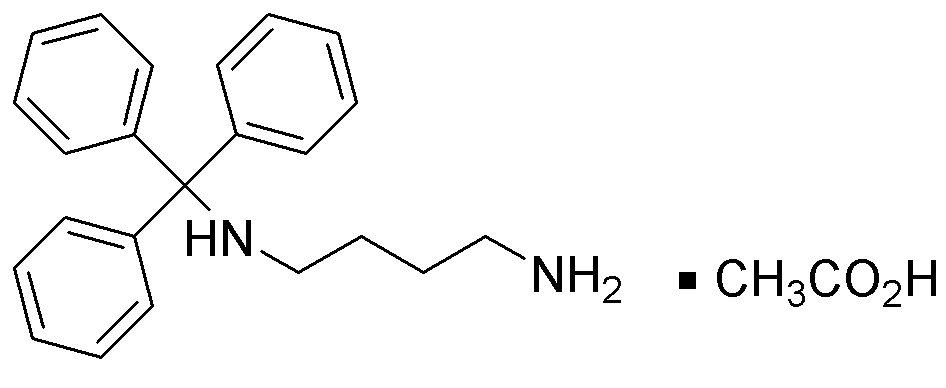Trityl-1,4-diaminobutane acetate is widely utilized in research focused on:
- Pharmaceutical Development: This compound serves as a key intermediate in the synthesis of various pharmaceutical agents, particularly in the development of drugs targeting neurological disorders.
- Bioconjugation: It is employed in bioconjugation processes to attach biomolecules to surfaces or other molecules, enhancing drug delivery systems and improving therapeutic efficacy.
- Polymer Chemistry: Researchers use it to create functionalized polymers, which can be applied in drug delivery, tissue engineering, and other biomedical applications.
- Analytical Chemistry: This chemical is valuable in the preparation of reagents for analytical techniques, aiding in the detection and quantification of various substances in complex mixtures.
- Material Science: It finds applications in the development of advanced materials, including coatings and composites, due to its ability to modify surface properties and enhance material performance.
General Information
Properties
Safety and Regulations
Applications
Trityl-1,4-diaminobutane acetate is widely utilized in research focused on:
- Pharmaceutical Development: This compound serves as a key intermediate in the synthesis of various pharmaceutical agents, particularly in the development of drugs targeting neurological disorders.
- Bioconjugation: It is employed in bioconjugation processes to attach biomolecules to surfaces or other molecules, enhancing drug delivery systems and improving therapeutic efficacy.
- Polymer Chemistry: Researchers use it to create functionalized polymers, which can be applied in drug delivery, tissue engineering, and other biomedical applications.
- Analytical Chemistry: This chemical is valuable in the preparation of reagents for analytical techniques, aiding in the detection and quantification of various substances in complex mixtures.
- Material Science: It finds applications in the development of advanced materials, including coatings and composites, due to its ability to modify surface properties and enhance material performance.
Documents
Safety Data Sheets (SDS)
The SDS provides comprehensive safety information on handling, storage, and disposal of the product.
Product Specification (PS)
The PS provides a comprehensive breakdown of the product’s properties, including chemical composition, physical state, purity, and storage requirements. It also details acceptable quality ranges and the product's intended applications.
Certificates of Analysis (COA)
Search for Certificates of Analysis (COA) by entering the products Lot Number. Lot and Batch Numbers can be found on a product’s label following the words ‘Lot’ or ‘Batch’.
*Catalog Number
*Lot Number
Certificates Of Origin (COO)
This COO confirms the country where the product was manufactured, and also details the materials and components used in it and whether it is derived from natural, synthetic, or other specific sources. This certificate may be required for customs, trade, and regulatory compliance.
*Catalog Number
*Lot Number
Safety Data Sheets (SDS)
The SDS provides comprehensive safety information on handling, storage, and disposal of the product.
DownloadProduct Specification (PS)
The PS provides a comprehensive breakdown of the product’s properties, including chemical composition, physical state, purity, and storage requirements. It also details acceptable quality ranges and the product's intended applications.
DownloadCertificates of Analysis (COA)
Search for Certificates of Analysis (COA) by entering the products Lot Number. Lot and Batch Numbers can be found on a product’s label following the words ‘Lot’ or ‘Batch’.
*Catalog Number
*Lot Number
Certificates Of Origin (COO)
This COO confirms the country where the product was manufactured, and also details the materials and components used in it and whether it is derived from natural, synthetic, or other specific sources. This certificate may be required for customs, trade, and regulatory compliance.

